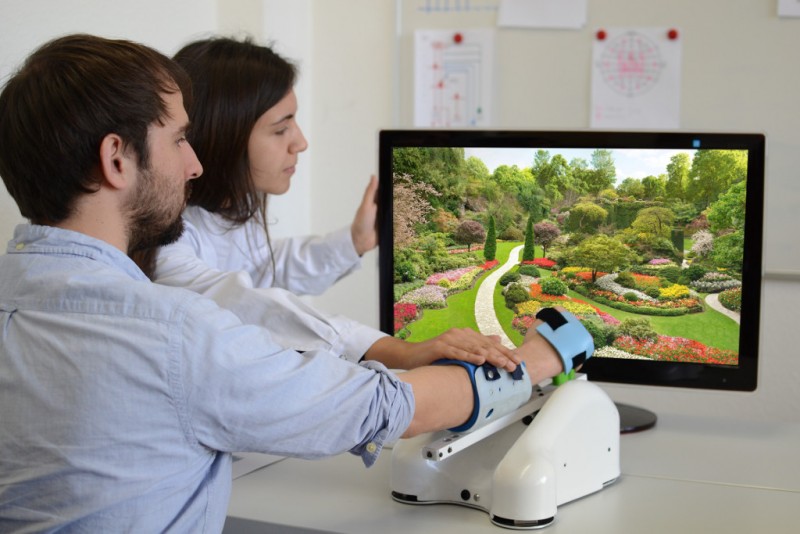Project AMoRSA
AMoRSA stands for “Adaptive and highly motivating platform for the rehabilitation of patients with arm palsy following a stroke“. The project kicked off on March 1st, 2017 (ending February 29th, 2020).
MOTIVATION
In Europe, millions of people live with chronic paralysis after a stroke. An efficient strategy for systematic rehabilitation measures that is suitable for everyday use can help patients regain their mobility and carry out important everyday activities such as eating, drinking or dressing without outside help.
GOALS AND PROCEDURES
The aim of the project is to enable stroke patients with complete arm paralysis to rehabilitate their mobility providing them with complete arm paralysis with efficient, highly motivating and systematic neurorehabilitation suitable for everyday use. For this purpose, a training system will be created whose central element is a brain-muscle-machine-interface, which controls an exoskeleton attached to the paralyzed arm. The movement feedback generated by the actuators reactivates compromised connections between brain and muscles closing the brain-to-muscle loop and producing functional neuroplasticity. In addition, the rehabilitation system is embedded in a digital health game that intuitively communicates health information and training progress to patients and continuously motivates them.
INNOVATIONS AND PERSPECTIVES
By combining an orthotic robotic system with a direct feedback function, a novel training system for neurorehabilitation will be developed and the first clinical pilot will be performed during the project. This rehabilitation environment enables chronically paralyzed stroke patients to participate in life without restrictions again.
SURVEY
The burden of stroke is dramatic at many levels and there is a lack of controlled clinical trials and cost/efficacy analyses to incorporate new methods into everyday clinical practices. Furthermore, in many of the new developments and therapies, there is a clear lack of stakeholders involved during clinical research to clinical trials and practice transition. Current trends in stroke rehabilitation include the use of robotics (mainly to compensate therapists shortage and increase of demand), the use of serious games (computer gaming, virtual and augmented reality) to increase patients’ engagement and intensity of training, the telerehabilitation (home-use video games and training and movement assessment gadgets) and the use of neural interfaces to re-activate dormant or to generate via neuroplasticity mechanisms, connections between brain and muscles. All these components are present in AMORSA project.
With this survey, we want to investigate the demographics of the steadily changing stroke survivors community (including not only patients but their caregivers and therapists), their common limitations, interests and their opinion about these new rehabilitation trends. Furthermore, we want to quantify the potential adoption of new-coming treatments/therapies based on these trends. We have designed 3 different surveys, one for the patients, another for their caregivers (family and relatives) and the last one for therapists (neurologists, physiotherapists, etc).
Patients: we want to quantify the a) impairment level of the patients, especially the chronic ones; b) their current involvement in treatment, prevention or assistive measures; c) their use of technology (TV, smart-phone, video-games, etc) and their technology literacy; d) expectation regarding new therapies based on the mentioned trends; e) acceptable duration and intensity of rehabilitation therapies based on the trends and their acceptance rate; f) social aspects within the stroke community (e.g. interest in patients forums); g) the cost/benefit or compromise of rehabilitation measures based on the trends (e.g. acceptable specifications of an implanted solution for rehabilitation or assistive technology and the movement restoration achieved); h) interest in home-based rehabilitation gadgets based on the trends.
Care-givers: we want to quantify the almost the same as for the patients but from their perspective (normally we have observed a significant difference in perception in aspects of interest, motivation, impairment, etc);
Therapists: we want to quantify their a) demographics and skills; b) the clinical assessment scales (e.g. ARAT, MRC, NIHSS, Fugl-Meyer) and rehabilitation methods used (e.g. robots, mirror, group therapies); c) their service characteristics/limitations (e.g. number of patients per therapist, time per session etc); d) new therapies based on trends minimum requirement to be adopted (e.g. preparation time, easy to use etc); e) compensation limitation to accelerate the adoption of new therapies; f) relevance of predictor of recovery or biomarkers for patients stratification for rehabilitation therapies; g) their opinion on cost/benefit or compromise of rehabilitation measures based on the trends (e.g. acceptable specifications of an implanted solution for rehabilitation or assistive technology and the movement restoration achieved); h) interest in home-based rehabilitation gadgets based on the trends.
Please take part in this survey by clicking on these links below:
Patients: https://www.soscisurvey.de/amorsa_reha1/
Relatives / caregivers: https://www.soscisurvey.de/amorsa_reha3/
Therapists: https://www.soscisurvey.de/amorsa_reha2/





